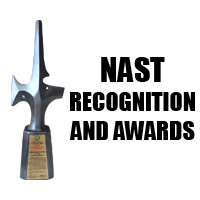The National Academy of Science and Technology Philippines, organized the Science Information Forum (SIF) on Rice Sufficiency: Price Rise and Importation Issues on November 26, 2014 at the La Breza Hotel, Quezon City. The SIF aims to inform the media on the causes of rice price increases in the Philippines and the possible effects of importation and/or trade policies.
Invited experts were Dr. Isabelita M. Pabuayon, dean of the College of Economics and Management (CEM) of the University of the Philippines Los Baños (UPLB), Dr. Agham C. Cuevas, Associate Professor of the Department of Economics, CEM, UPLB, Dr. Flordeliza H. Bordey, Senior Science Research Specialist of the Philippine Rice Research Institute, and Mr. Joseph Y. dela Cruz, Assistant Administrator for Marketing Operations of the National Food Authority (NFA).
Dir. Luningning E. Samarita-Domingo welcomed the participants on behalf of Academician William G. Padolina, president of NAST PHL.
Dr. Pabuayon and her co-author, Dr. Cuevas, presented their study on the analysis of the rice price trends in the country. She discussed the overview of the rice market of the Philippines as compared with the world figures, rice price trends, as well as marketing-related concerns. She said that issues concerning rice self-sufficiency, food security, and price stability were interrelated. She reported that the comparative rice per capita consumption in selected Association of Southeast Asian Nations (ASEAN) countries showed that the Philippines ranked below most of its ASEAN neighbors, and conversely, significantly higher than the global average. According to her, supply and demand lead to price formation, where price affects consumer’s willingness to buy. Further, she stated that food security is the bottom line, that is, food should be available, accessible, and affordable at all times. On the marketing-related issue, it was ruled out that no evidence of collusion was found among farm to wholesale and at the retail levels.
Dr. Bordey discussed the rice sufficiency program implemented in the country. She reported that the Aquino administration had engaged in the Food Staple Program. She said that the rice price was stable in the international setting and yet it has increased locally. She stated that if self-sufficiency in rice is high, the better the image projection of the country. She mentioned that if there is an increase in demand and production is low then imports would increase. According to her, the country cannot target self-sufficiency and stable price at the same time, and concluded that rice price will depend on self-sufficiency.
Mr. Dela Cruz tackled the government rice marketing and distribution system in the country. He reported the initiatives of the NFA on food security. According to him, to ensure food security, NFA must maintain and manage buffer stocks through the importation of rice. On rice importation, the volume to be imported during a state of calamity should be determined by an inter-agency committee on rice headed by the Department of Agriculture. In addition, for the period of November 1 to June 30, he reported that the NFA was required to maintain its warehouses rice stocks equivalent to 15 days of consumption for the entire country. According to him, this buffer stocking activity should be equivalent to 90 days or three months of consumption, as determined by the government, corresponding to the period of the lean season when normally there are no harvests from the domestic rice crop.
An open forum was conducted after the presenters have discussed their topics. Academician Eufemio T. Rasco, member of the NAST Agricultural Sciences Division, delivered the synthesis of the forum while Academician Agnes C. Rola, focal person and member of the NAST Social Sciences Division moderated the activity. It was attended by 50 participants from the media sector.
Invited experts were Dr. Isabelita M. Pabuayon, dean of the College of Economics and Management (CEM) of the University of the Philippines Los Baños (UPLB), Dr. Agham C. Cuevas, Associate Professor of the Department of Economics, CEM, UPLB, Dr. Flordeliza H. Bordey, Senior Science Research Specialist of the Philippine Rice Research Institute, and Mr. Joseph Y. dela Cruz, Assistant Administrator for Marketing Operations of the National Food Authority (NFA).
Dir. Luningning E. Samarita-Domingo welcomed the participants on behalf of Academician William G. Padolina, president of NAST PHL.
Dr. Pabuayon and her co-author, Dr. Cuevas, presented their study on the analysis of the rice price trends in the country. She discussed the overview of the rice market of the Philippines as compared with the world figures, rice price trends, as well as marketing-related concerns. She said that issues concerning rice self-sufficiency, food security, and price stability were interrelated. She reported that the comparative rice per capita consumption in selected Association of Southeast Asian Nations (ASEAN) countries showed that the Philippines ranked below most of its ASEAN neighbors, and conversely, significantly higher than the global average. According to her, supply and demand lead to price formation, where price affects consumer’s willingness to buy. Further, she stated that food security is the bottom line, that is, food should be available, accessible, and affordable at all times. On the marketing-related issue, it was ruled out that no evidence of collusion was found among farm to wholesale and at the retail levels.
Dr. Bordey discussed the rice sufficiency program implemented in the country. She reported that the Aquino administration had engaged in the Food Staple Program. She said that the rice price was stable in the international setting and yet it has increased locally. She stated that if self-sufficiency in rice is high, the better the image projection of the country. She mentioned that if there is an increase in demand and production is low then imports would increase. According to her, the country cannot target self-sufficiency and stable price at the same time, and concluded that rice price will depend on self-sufficiency.
Mr. Dela Cruz tackled the government rice marketing and distribution system in the country. He reported the initiatives of the NFA on food security. According to him, to ensure food security, NFA must maintain and manage buffer stocks through the importation of rice. On rice importation, the volume to be imported during a state of calamity should be determined by an inter-agency committee on rice headed by the Department of Agriculture. In addition, for the period of November 1 to June 30, he reported that the NFA was required to maintain its warehouses rice stocks equivalent to 15 days of consumption for the entire country. According to him, this buffer stocking activity should be equivalent to 90 days or three months of consumption, as determined by the government, corresponding to the period of the lean season when normally there are no harvests from the domestic rice crop.
An open forum was conducted after the presenters have discussed their topics. Academician Eufemio T. Rasco, member of the NAST Agricultural Sciences Division, delivered the synthesis of the forum while Academician Agnes C. Rola, focal person and member of the NAST Social Sciences Division moderated the activity. It was attended by 50 participants from the media sector.











